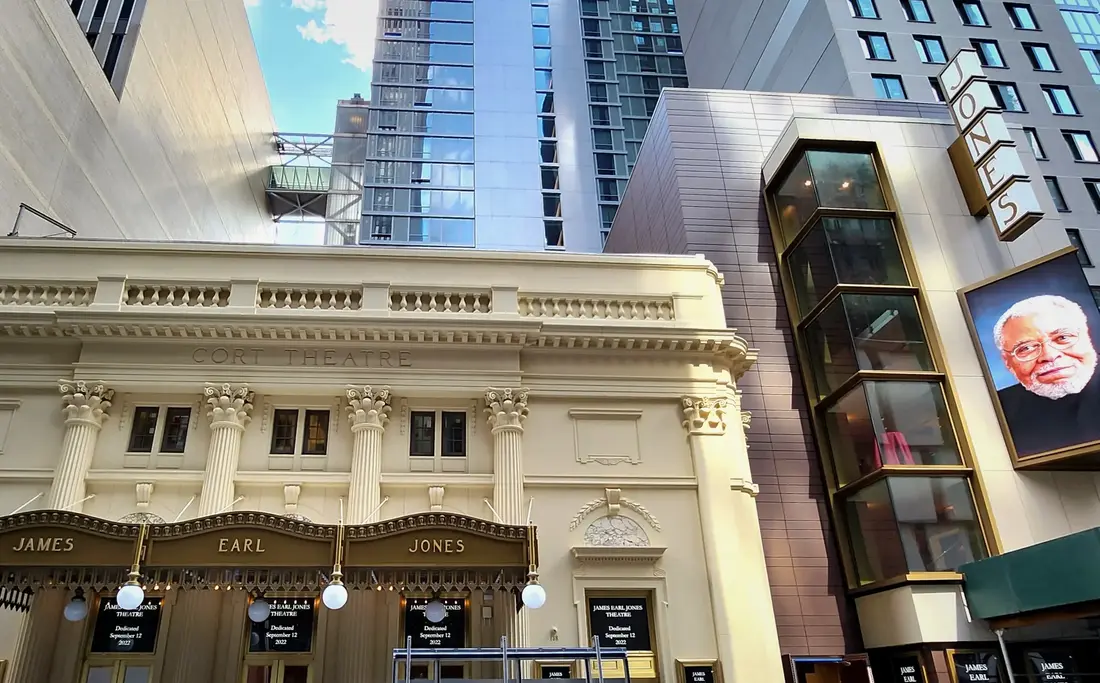James Earl Jones Theatre Information

The James Earl Jones Theatre has only been known by its current name for a short time. Before that, it was the Cort Theatre, a nod to its original operator, John Cort.
Although Cort was born and raised in New York City and initially attempted to carve out a theatrical career in the Big Apple, he didn’t get his first taste of success until relocating to Seattle, where he served as the theater manager for the Standard Theater. The talented impresario also started a theater circuit in the early 1900s called the Northwestern Theatrical Association and owned about 150 theaters, which was more than anyone else in the country at the time.
Still, Cort never lost sight of his dream to make it big in NYC, and in 1905, he headed back east and helped start the National Theatre Owner’s Association, which had the backing of the powerful Shubert Organization. Cort parlayed this into an opportunity to begin building theaters in Manhattan’s burgeoning Theater District.
Even though many Broadway insiders considered Cort an outsider, he convinced developer Edward B. Corey to help him build the Cort Theatre and lease it to him. Well-respected theater architect Thomas Lamb was hired to design it, and it opened in December 1912.
The Cort Theatre was successful from the start. Its first production Peg o’ My Heart stuck around for more than 600 performances. The venue’s next two shows, Under Cover (1914) and The Princess Pat (1915), also enjoyed great success.
The hits kept coming throughout the rest of the 1910s and early 1920s. The Cort Theatre hosted long-running shows like Flo-Flo (1917), Abraham Lincoln (1919), and Book of Job (1922).
As Cort retired in 1927 and the Shubert Organization bought the theater, big changes were on the horizon. But even that didn’t slow down the Cort Theatre, which continued to produce successful shows throughout the 1930s, 1940s, and 1950s.
The biggest highlight came in 1958 when James Earl Jones made his Broadway debut in Sunrise at Campobello, which enjoyed an impressive run that lasted for over 500 performances. This set the stage for the Cort Theatre becoming the James Earl Jones Theatre later on.
In the meantime, the Cort Theatre endured a short slump that saw a string of unsuccessful productions throughout the 1960s. It even stopped hosting theatrical performances in the late 1960s and early 1970s when it leased the theater to broadcast The Merv Griffin Show.
Once CBS ended its lease, the Cort Theatre returned to its roots by releasing another collection of hits through the end of the 20th century, including Home (1980), The Grapes of Wrath (1990), and The Heiress (1995). This set the tone for the start of the 21st century, which saw the Cort Theatre host Fences (2010), Breakfast at Tiffany’s (2013), and King Lear (2019).
Like other Broadway theaters, the Cort Theatre was forced to shut down in 2020 because of the COVID-19 pandemic. However, it made the most of the situation by undergoing a $47 million renovation and expansion, including adding a new annex.
The Shubert Organization also used this break to honor its commitment to improving its racial and cultural diversity by changing the name of the Cort Theatre. When it returned in late 2022, it was officially the James Earl Jones Theatre.
About the Venue
The James Earl Jones Theatre is located at 138 West 48th Street in Midtown Manhattan’s Theater District. It’s one of the few remaining theaters designed by architect Thomas W. Lamb. It features three floors and 1,092 seats.
While the theater is over a century old and has undergone numerous renovations, it maintains the same neoclassical design it had when it opened. Its show-stealing facade has an impossible-to-miss marquee made out of glass and metal. It also has a colonnade, and the names of both John Cort and James Earl Jones are prominently featured.
The interior of the theater is just as aesthetically pleasing as the exterior. The lobby features stunning marble paneling along with an equally attractive coved ceiling. The ceiling also boasts a huge central medallion with a beautiful chandelier constructed of bronze and crystal.
But the crown jewel of the James Earl Jones Theatre’s interior is its auditorium. It has two balconies, private boxes, and an ahead-of-its-time proscenium arch featuring a special art glass that illuminates during performances.
The theater’s facade, lobby, and auditorium received New York City Landmark status in 1987. Thanks to the gorgeous annex added in 2022, the theater takes on a more modern appearance than neighboring theaters. It houses lounges, restrooms, and backstage areas.
Venue History
When Edward B. Corey agreed to help John Cort build the Cort Theatre and lease it to him, the two included a couple of interesting stipulations in their lease agreement. First, they agreed Thomas W. Lamb would design every aspect of the theater, outside of recommendations from Corey and Cort. However, they also agreed that the Cort Theatre wouldn’t include any design features considered inferior to those found in the Playhouse Theatre, which was built one year prior on a lot across the street.
Cort’s critics likely would have been skeptical about him living up to this lofty agreement. However, early reviews of the Cort Theatre revealed that Cort, Corey, and Lamb hit the mark, with one critic referring to it as “one of the most exquisitely beautiful playhouses in Manhattan.”
However, Cort refused to rest on his laurels when the Cort Theatre held its grand opening in December 1912 and started welcoming spectators into its auditorium to see its initial shows. The venue got off to a strong start with Peg o’ My Heart, and Cort followed that up by handing famed theatrical producer Oliver Morosco the exclusive rights to showcase his performances at the Cort Theatre for five years in 1913.
This would turn into a theme throughout the Cort Theatre’s two decades. Cort did much of the heavy lifting by putting on his own productions, but he also enlisted the services of other theatrical producers, like Morosco, the Shubert brothers, and Arthur Hammerstein, to help him provide theatergoers with world-class productions.
This approach didn’t always deliver the intended results, as Cort ended up in the middle of a court battle in 1925 after allegedly promising exclusive theatrical production rights to three different producers at one time. But for the most part, Cort and, by extension, the Cort Theatre excelled from when the theater opened in 1912 through 1927, when Cort retired, thanks to his willingness to allow other top-notch producers to spread their wings. All of these efforts helped legitimize the Cort Theatre.
This trend continued even after Cort called it quits on his theatrical production career. After taking over, the Shubert Organization took a similar approach to putting on productions at the Cort Theatre. They trusted Broadway entrepreneur Joseph Leblang to oversee the venue from 1928 through 1932, for example, and he responded by featuring shows like These Days (1928), which marked Katharine Hepburn’s Broadway debut.
But the real secret to the Cort Theatre’s success wasn’t much of a secret at all. Outside of picking the right theatrical producers, Cort and then the Shubert Organization also greenlit high-quality performances and didn’t miss the mark very often. This helped the theater string together many hits over its first 100 years, including:
» The Yellow Jacket (1916)
» Captain Applejack (1921)
» The Second Mrs. Tanqueray (1924)
» The Jazz Singer (1925)
» The Green Bay Tree (1933)
» The Respectful Prostitute (1948)
» The Father (1949)
» The Rainmaker (1954)
» The Magic Show (1974)
» Sarafina! (1988)
» On Golden Pond (2005)
» Fish in the Dark (2015)
Early on, the Cort Theatre earned a reputation for being “lucky” because of all the hits it amassed. However, as time went on, it became clear that the theater’s success was more than just magic. Management and its handpicked theatrical producers have put on shows people want to see time and time again.
The Shubert Organization undoubtedly expects this trend to continue as the Cort Theatre forges ahead as the James Earl Jones Theatre.
More James Earl Jones Theatre information:
Ticket Policies:
Policies and authenticity guarantee regarding tickets from our recommended ticket marketplace.
Seating Chart:
View the standard James Earl Jones Theatre seating map and read about different seating options.
Parking Information:
Information about the James Earl Jones Theatre parking options.
